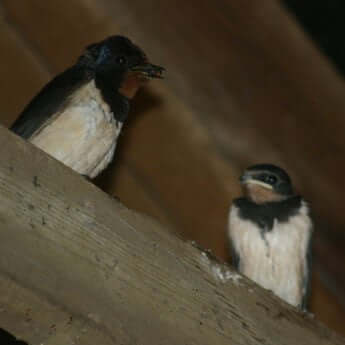
Who says one swallow doesn't make spring?
Share
Swallows have dark blue backs, red throats, pale under parts and long tail streamers. Here is a guide to understand the mind of a swallow.
April is awash with firsts: first flowering Elder; first leaf on Field Maple; first young Blackbirds; first recorded Nightingale and first Peacock butterflies – but none of them, to my mind, say spring is here quite like the very first Swallows returning from Africa.
Swallows have it all - they look like “sleek, streamlined miniature jet planes,” according to Bill Oddie. And who am I to disagree? “Close up, they have a charming red bib, and eyes as big and dark as a baby seals, a beak set in a permanently benign smile, and a cheery jumble of a song that is the very definition of the word “twitter.” How can I compete with that description? I can’t. I will just add that my fascination with swallows is not so much how they look (although they do look amazing) – it’s what they do that fascinates me…
From childhood I’ve always been gripped by migration and swallows seem to me to be the champion migrants. Swallows nest in northern Europe, fly south to winter in Southern Africa, and then return back to northern Europe on an epic journey of around 10,000 miles – covering around 200 miles per day, flying at a maximum speed of 35mph. If this is not action that’s deserved of champion status, I do not know what is. However, here’s a sobering thought: every Swallow fledgling will set out on the return journey to Africa sometime around September and October. (These dates are firmly set in my mind as Swallows nested in my garage for more than ten years. It was always a delight when they arrived and we wished them bon voyage when they gathered to depart, as Swallows do).

When you spot your first Swallow this spring (if you haven’t already) just stop and think for a moment that these champions of flight have been dog fighting through the legs of Giraffes, skimming over watering holes frequented by hippos, made their way through mountain passes in the Pyrenees and hoovered-up (sorry, vacuumed up!) insects barely a foot above the dunes in the Sahara desert.
Those who know about birds know you can’t feed Swallows. However much I love the idea and challenge of creating a mid-air refuelling station for Swallows it’s not something that’s likely to happen. Or is it… If you’d like to feed Swallows (and other birds that feed “on the wing”) here’s what worked for me in my garden:
A pond is the first port of call. Anything that sustains life attracts life, and Swallows are of course adept to skimming the surface of ponds. What gathers above the surface of ponds? Lots of juicy, protein-rich invertebrates: daddy long legs and dragonflies – Swallow food! So they can be fed – it just takes a slightly different approach.
Not only can they be fed we can help them to build and secure their nests. We can opt for a pre-built Swallow nest or – at times when there’s less rainfall and mud is hard to find – we can make a mud pie for Swallows by leaving soil in a wheelbarrow and watering it daily. If you’re lucky, you might see Swallows using “your mud” to build or re-build their nests. How amazing would that be?
I’ll let Bill Oddie have the last word as he does this much better than me: “If you have an outhouse, garage or porch – anything with shelves and beams – you are providing an ideal home for breeding swallows and their families. Make sure they can get in and out! (Simon King: getting out is of course important. But if they get in through an open garage door, how will they get out when the door is closed? Perhaps you could remove a brick or piece of glass? That’s what I used to do!). If they are successful, you may be treated to the classic image of autumn – parallel telegraph wires, with swallows dotted along them like notes on a musical stave. Meanwhile, they say “one swallow doesn’t make a spring”, but spring is definitely here, and so soon will be the swallows. Enjoy them.”

